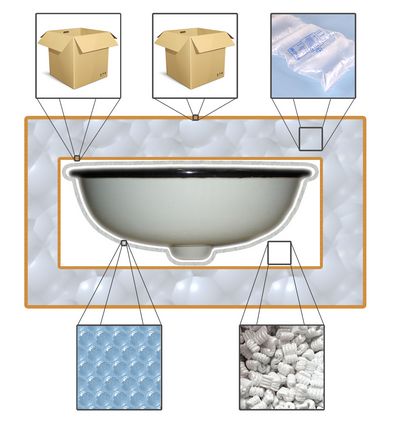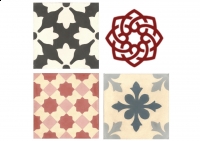FAQ – Frequently asked questions
Subject:
Ceramic sinks Copper sinks Delivery and returns Why it is worth buying with us Methods of Payment
Ceramic Sinks
1. Are the bowls durable?Yes, the bowls are very durable. Thanks to a centuries-old technique of making the product, high quality materials and a careful process of manufacturing, the basins are exceptionally durable. The quality of the bowls has been certified by a European Certificate of Safety (CE mark). The bowls have undergone laboratory tests for heat resistance, staining, abrasion and scratching. We would also like to inform you that the bowls are made from ceramics and as always with products made from such a material they might get damaged due to improper use.
2. Are the designs on the bowls resistant to abrasion?Yes, the designs on the bowls are resistant to mechanical and chemical damage. Since each element of the design is made with use of paint, which is at the same time part of the glaze, the designs are resistant to abrasion and scratching. In case of scratching the surface of the bowl (unfortunately, titanium coating for basins has not been invented yet), the design remains intact due to the fact that the bowl was covered with a thick layer of paint/glaze.
3. Are the sinks safe for health?Yes, our bowls are safe for your health. All the materials and substances used in the process of manufacturing the bowls are of natural origin. The pigments included in the glaze are lead-free.
4. Do the sinks have an overflow hole? No, most Moroccan sinks in our shop (excluding Round Vessel Sinks) don't have got an overflow hole.
5. What is the size of the drain hole?All the ceramic wash basins have got a standard size drain hole.
6. What does the process of producing Moroccan look like? 
The process of manufacturing Moroccan sinks starts from mixing two kinds of clay. The mixture remains in water to soak, so that the quality of the clay improves and it is possible to shape it. After soaking the clay, the remaining water is drained, all impurities get removed and then the clay is kneaded with feet. Pieces of the clay are then placed in moulds (depending on the type of a bowl) and moroccan sink shaped in this way will dry for eight up to twelve weeks. The first burning of the clay takes place at a temperature of 850 degrees. Each bowl is covered with natural ceramic glaze, which imparts characteristic glow and colour to it. After putting on glaze, the bowls are hand painted with the use of paints prepared from mineral pigments. The bowls are then fired again, but this time at a temperature of 1050 Celsius degrees so that they obtain final durability and beauty.
7. Is it possible to see your wash basins in a regular store? At present we do not run a offline store. However, in the nearest future we are going to exhibit individual products in the largest bathroom showrooms in Poland so that it would be easier for our customers to make a decision.
8. Will the basin be exactly like the one in the photograph? Due to the fact that each bowl is hand painted (the design is also put on by hand) and each of them is unique, the bowl delivered to you may slightly differ from the one shown in the photograph. The differences may be visible only in tiny details of the design.
Back to top
Copper sinks
Our copper copper sinks and bathtubs are completed with a patina finish that is fired into the material, giving them an aged appearance. The key to maintaining copper sinks and bath tubs in perfect condition is all about avoiding scrubing and using abrasive materials that might damage the protective patina.
1. How to clean copper sinks and bathtubs?It is enough to use clean water with a delicate detergent for everyday cleaning of copper. However, if in the region where you live there is hard water, it is worth wiping the bowl with a smooth dry cloth from time to time. With a view to additional protection, you may wipe the bowl with furniture polish. Polishing the surface of the bowl regularly with furniture polish will help you to keep the sheen of the bowl and will allow for faster flow of water out of it (it helps to keep it free of mineral deposit). You will find more information on how to clean copper:
here.
2. How to care for a Copper sinks and Bathtubs? 1.
1. Apply a wax coating to your copper bathtub regularly, about once a month or so. The wax will lock in the brownish color of the tub. Beeswax is an acceptable wax to use. If your new copper bathtub already had a wax applied at the store or manufacturer, skip this step for now, but be sure to apply more wax when the initial wax wears off.
2. After bathing, dry your copper bathtub with a soft cloth. A polishing rag, like you'd use for car care, works well. A flannel cloth is also soft enough to get the job done.
3. Once a week or so, depending on need, wash out the copper bathtub. Use a gentle soap and a soft cloth to carefully scrub dirt and grime off. Steer clear of corrosive cleansers, such as ammonia and vinegar.
3. What should I beware of?While cleaning and using a copper basin, you should be cautious with any caustic substances, any substances containing chlorine or any substances which might damage the surface mechanically (e.g. scouring powders). If the colours on the surface of your bowl fade a little or change the tone, don't worry, because with time the faded places will take on a natural patina. You should be cautious with substances which might change the colour of the natural patina on copper, like: orange or lemon juice, ketchup, toothpaste, vinegar. Also, we do not recommend using sand or a scourer for cleaning copper bowls.
4. Is copper safe for your health?Copper is totally safe for your health. Additionally, copper has got natural antibacterial properties and is 'healthier' than most other metals used for producing wash basins. Scientific research has proved that bacteria may live on metal surfaces for many days, whereas on copper surfaces they can survive only a few hours.
5. What can be done with a patina?Copper tarnishing is a natural process of copper oxidation and it is not harmful for health. Although patina adds originality to a basin, after some time there may be too much of it. We are presenting a few methods of removing the excess of a patina (or of cleaning bowls not covered with a patina), which are both delicate and safe for the surface of your bowl. You may clean the surfaces with the use of special copper polishes or with one of specifics prepared at home. Try one of the following methods:
a) Copper ware may be cleaned with ammonia or vinegar mixed with salt (a handful of salt boiled with a glass of vinegar). Then rinse the surface with clean water, dry it and polish.
b) At the chemist's you may buy oxalic (it has a form of white crystal grains). Pour oxalic into an adequate amount of water so that it becomes a saturated solution. With the use of a cloth, apply the solution onto the cleaned copper surface and after a few minutes rinse it with water. You may repeat the process until you get the required effect. The oxalic solution is not caustic and it reacts well with copper oxides. At the same time, it does not react with the metal itself.
c) Grate a peeled potato or mix it finely. Put the mush onto the surface which you wish to clean and wait until it dries. After drying, remove the mush and wipe the surface with alcohol.
Back to top
Our Clients in Europe
Show Clients on a larger map
Spanish Floor Tiles
1. Cleaning: Once the tiles are placed, clean them using a brush and non-abrasive liquid soap, never with chemicals or lye. It is important to wait until the base and tiles are perfectly dry in order to avoid spots when applying treatment. The tiles need to breathe and all humidity must evaporate before the treatment can be applied (the evaporation of the water can leave white calcium deposits on the tiles, which will be removed when washing the tiles with soap). If there are still spots after cleaning, gently rub the tiles with sandpaper and water.
 2. Treatment
2. Treatment a) Wax: Wax is traditionally used to protect the mosaic, to intensify its colors and give it a smooth, glossy finish. Initially, the liquid, colorless wax is applied over the tile, once it hardens, it is removed with water. This process will need to be repeated two or three times per month.
b) Foam: . This treatment protects the tile from water, oil, and other substances that can cause spots. This treatment is applied with a roller to uniformly cover the tile, without excess, with a fine layer of the foam-like substance. This is used to protect both the ground and the tile, without excess.
c) Crystallization: This is the most comprehensive treatment. This hardens, protects, and polishes the mosaic tile. Its application is similar to that which is done with marble or terrazzo. It uses a polishing machine, steel wool, and magnesium silicate. We recommend professional application of this treatment.
3. Tile Placement 1- The placement of the tiles is simple and quick. For perfect execution it is necessary to place the tile on dry, level ground . Never place the tiles in wet cement. In addition, the base on which the tile will be placed should be completely dry, since any humidity will cause spots on the tiles.
2- Once the base for the tile is ready, you can begin to place the tiles. Dampen the tiles before placing them on the surface to assist with bonding to the cement base.
3- The base for each tile will need to be manually made level, one by one without a hammer or other tools. We recommend using a lot of cement and using a rake to smooth it out. The smooth surface will improve adhesion and help avoid damaging the tile in the future.
4- It is very important to have a perfectly level base and dampen the tiles, we cannot stress this enough, because after the tiles are placed it is not possible to change how they are positioned or to restore a polished look.
5- The space in between tiles needs to be minimal, 1 mm, and this alignment should be consistent to obtain the look you expect.
6- For grout in between tiles, we advise dampening the tiles, again, and using a very liquid cement. This liquid cement grout will fill in the spaces well. Apply the grout little by little, because it dries quickly. Also, use a lot of water to clean off any remnants of the grout on the tiles.
7- Finally, cleaning the tiles and the grout is fundamental. Remove all excess cement and grout using sandpaper and water (number 600) to prevent spots on the tiles.
Back to top
Delivery, guarantee, returns and prices
1. Delivery options In our shop there are two options of delivery available
- Courier : 30 zl for Poland and 100 zl (approximately 25 euro) for international shipping
International deliveries are being handled by company UPS. They’re fast and reliable.
- Self collection (free of charge)
You may collect the ordered product straight from our storehouse in Warsaw. O
2. Shipping cost
The postage depends on the value of the order:
- Starts at 25 Euro (depending on location and size of the order) Please see the pricing over here:
Delivery 3. GuaranteeOur products have 2 years guarantee (the guarantee does not cover damage caused by improper use).
In case of a return of a product under guarantee, we will replace it with another one, or if there are no such left in the storehouse or if it is impossible to order one from the manufacturer, we refund the whole cost of the purchase. The goods damaged in transport may only be returned if the courier confirms that the product was defective on arrival (please remember to open the parcel in the courier's presence).
4. Exchange and returnsWe believe that our products will fulfill all the expectations of our customers. However, we are aware that in case of products so original and unique like ours, the decision whether to buy them or not may be difficult. Still, if you have made up your mind and bought our product, but on second thoughts you feel that it does not fulfill or suit your needs, there is an option of return or exchange for another one (at the same price). You may return the product within 5 working days from the day of the delivery.
Why it is worth shopping with us
Our goal is not only to deliver you the original products of the highest quality, but also to provide you with a satisfying service and products at competitive prices. Products offered by the competition are sometimes cheaper than ours, but it does nor really mean that they are going to cost you less. Buying with us, you will definitely:
1. Not pay customs duty (customs duty is calculated and based on the cost of a given commodity and the shipment)
2. Not pay any extra VAT (added tax based on the cost of the commodity, shipment and customs duty). The VAT is imposed at customs so the prices given by our competition (in case of a shipment from Morocco) do not include the hidden cost. All our prices include VAT.
Moreover:
3. You will receive the good within a few days and not, as it happens with our competition, after months of waiting until the product arrives from abroad, which may take up to three months because the product is usually not even produced yet and once it is, it must be sent across the ocean by ship.
4. You are given a possibility of returning the good free of charge ( without giving a reason for doing so), lodging a complaint or exchanging the good if you are not satisfied with the design or the model.
5. You gain certainty that the transaction will be handled securely thanks to the systems of payment: platnosci.pl, dotpay and Paypal.
6. You may always count on us to assist you, advise you and offer discounts in case of larger orders. Also, you will not hear us saying: 'We are sorry but it is the courier's fault that you have not received the ordered goods yet.'
Back to topWe hope that we have managed to answer most questions. However, if you still have some doubts or queries, feel free to contact us via e-mail. We will be happy to answer any questions.



